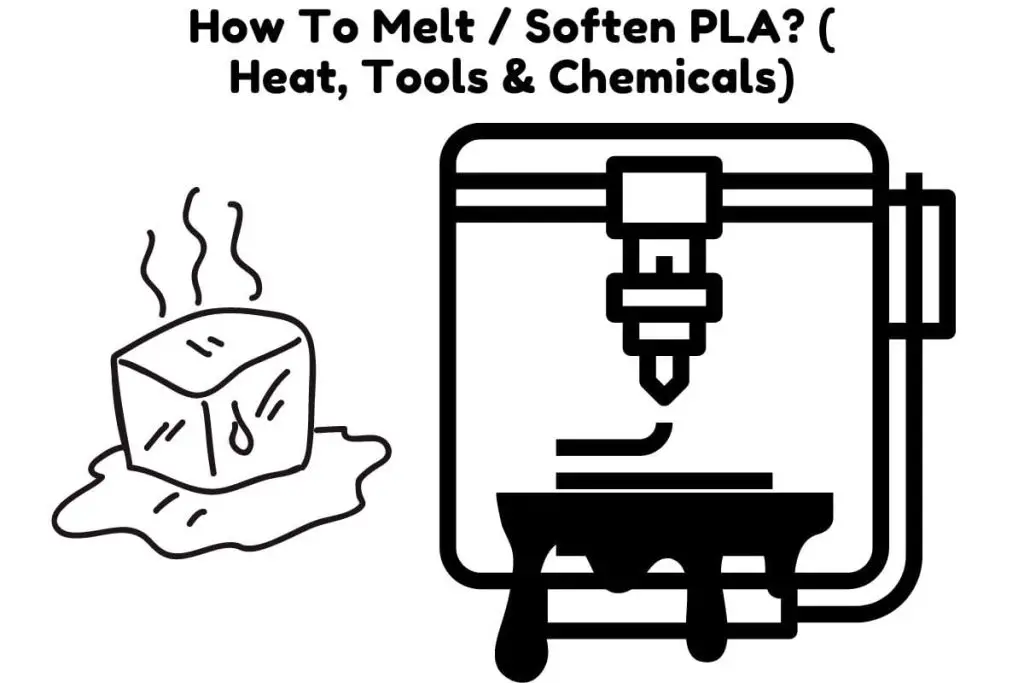PLA is the easiest material to work with. It is cheap, does not warp easily, and is easy to find in a variety of colors and variations. Post-processing a PLA print can add a professional touch to it.
A 3D print will always come out looking a little rough. You can expect your prints to have layer lines and maybe a gap or two. Layer lines are the visible separation lines between each extruded layer of filament.
Gaps, holes, or cracks can be caused by a number of things such as using wet filament or using the wrong printer settings for the material you are working with.
Post-processing a print involves among other things, smoothing it to remove layer lines and gaps to produce a better finish. It removes the “3D printed look” and makes it look more like an injection molded part.
On a side note! If you’re looking for a reliable and high-quality 3D printer, we highly recommend the Official Creality Ender 3 V2 Upgraded 3D Printer (Amazon Link).
This printer is an upgraded version of the popular Ender 3 model, with a range of new features and improvements that make it even easier and more convenient to use.

You do not always need to smooth every print, especially if you’re just making a prototype for which aesthetics are not important.
But if you do need to smooth your prints it helps to know what you can and just as importantly, what you cannot use. In this guide, we evaluate more than seven different techniques for smoothing PLA. Can you smooth your PLA prints with alcohol, nail polish or even boiling water?

- What Temp Does PLA Soften?
- Can You Melt PLA And Reuse It?
- How Many Times Can PLA Be Melted?
- Is Melting PLA Toxic?
- Can You Melt PLA In A Microwave?
- Can You Melt PLA With A Hair Dryer?
- Will A Lightbulb Melt PLA?
- Will Boiling Water Melt PLA?
- What Happens If You Soak PLA In Water?
- At What Temperature Does PLA Dissolve?
- Does PLA Dissolve In Alcohol?
- Will Denatured Alcohol Dissolve PLA?
- Does Paint Thinner Melt PLA?
- Does Nail Polish Remover Melt PLA?
- Can PLA Be Smoothed With Acetone?
- What Solvent Will Melt PLA?
What Temp Does PLA Soften?
PLA has a glass transition temperature of 60°C. The glass transition of a material is the temperature at which a material becomes soft. It is different from and should not be confused with the melting temperature of a material.
The melting temperature is the temperature at which the material melts and becomes viscous enough to be extruded. For PLA this is between 180 and 230°C.
Knowing the glass transition of the material you are working with is an important design consideration. It will determine where and how you should use it and what you can use to soften it for post-processing.
Different materials have different glass transitions and you should take note of them before you start a new project. Source
To better understand this topic, we highly recommend that you check out our post ” What Happens If You Overheat Your 3D Print? Complete Temperatures Guide “
Can You Melt PLA And Reuse It?
One of the key features of FDM printing is that prints or print scraps can be melted and recycled to create new filament. This is because filament is a thermoplastic. It melts when heated but does not burn in a reversible process. Resin in contrast is a thermoset. Once it hardens it cannot be recycled.
How Many Times Can PLA Be Melted?
PLA can be melted an infinite number of times. The key consideration here, however, is to ensure nothing is added to it when it is melted. As long as it remains in its undiluted form it can be melted an indefinite number of times.
Is Melting PLA Toxic?
Plastic emits harmful toxic fumes when melted. PLA, ABS, and all other filaments release Volatile Organic Compounds (VOC) during printing. The fumes are hazardous when inhaled. Research into how hazardous these fumes are is still in the early stages. They are, however, thought to affect the respiratory system and even increase the chances of getting cancer.
Taking precautions when printing is therefore advised. Some of the most important precautions you should take are:
- Printing in a well-ventilated room.
- Not printing in your living spaces.
- Using your printer inside an enclosure.
Also, check out our post “Do 3D Printers Need To Be Vented? What Every Owner Must Know!“
Can You Melt PLA In A Microwave?
Microwaves have a maximum temperature of 120°C At that temperature PLA will soften and warp but will not melt. PLA melts at a minimum temperature of around 180°C so it will not melt in a microwave.
Can You Melt PLA With A Hair Dryer?
A standard hair dryer has a maximum temperature of 140°C. The most a hair dryer can do on PLA is soften it at that temperature as this is below the 180°C PLA melts at.
Will A Lightbulb Melt PLA?
Lightbulbs are the hottest close to the base. This might be a maximum of 80°C. The rest of the bulb is cooler, reaching room temperature at most. This would be around 30°C. PLA needs at least 180°C to melt so a standard lightbulb will not melt it.
Will Boiling Water Melt PLA?
Boiling water reaches a maximum of 100°C. While this is hot enough to soften most plastics it will not however melt them. PLA can be immersed in boiling water but will not melt as it has a higher melting point than the maximum temperature the water reaches.
What Happens If You Soak PLA In Water?
Water resistance is a necessary feature for prints that will be exposed to water. This might be an item that will be used outdoors or as part of a filtration system for example. PLA is water-resistant and can last for years when immersed in water.
At What Temperature Does PLA Dissolve?
Dry smoothing PLA through sanding and polishing is labor-intensive and takes the longest. Dissolving is a quicker, much less labor-intensive way of smoothing PLA. It is also an easier way to clean nozzles and build platforms. PLA dissolves or melts at a minimum temperature of 180°C.
You can thus dissolve PLA to process it or clean it off your printer. One way to do so is by using chemicals.
Does PLA Dissolve In Alcohol?
Generally, PLA will not dissolve in alcohol. Several home tests have proven that PLA remains intact even when soaked in an alcohol bath. Polysmooth is a brand of PLA the manufacturers claim is soluble in isopropyl alcohol.
Will Denatured Alcohol Dissolve PLA?
Denatured alcohol is alcohol that has been mixed with an additive to make it taste or smell bad. Ethanol is the most common example. Denatured alcohol is sometimes used as a substitute for acetone products. PLA will not dissolve in denatured alcohol.
Does Paint Thinner Melt PLA?
Paint thinner is an acetone-based solvent. Most types of PLA will not dissolve when treated with paint thinner. It is possible to use the thinner to strip off the paint on a PLA print without necessarily damaging the PLA underneath.
Does Nail Polish Remover Melt PLA?
Nail polish contains acetone. While acetone is a solvent it does not readily react with PLA in its pure form. This makes nail polish a less-than-effective solution for smoothing PLA. It may produce better results with ABS which responds better to acetone treatment.
Can PLA Be Smoothed With Acetone?
Acetone is an active ingredient in several household products like nail polish removers. Acetone is more commonly used for smoothing ABS. While it can be used on PLA, it does not always produce the best results as the plastic tends to become soft and sticky. This is because PLA itself does not react to acetone but the plasticizers or additives mixed with a PLA filament will.
Before using an acetone-based chemical it is better to test it on a small area of your print to see how it reacts.
What Solvent Will Melt PLA?
The most commonly used solvents for dissolving PLA are Ethyl acetate, butanone, Tetrahydrofuran (THF), Caustic soda (sodium hydroxide), and Dichloromethane (DCM). Ethyl acetate is the safest and easiest to use. They are all, however, toxic chemicals that should be handled with care as they are harmful when inhaled or mishandled.
